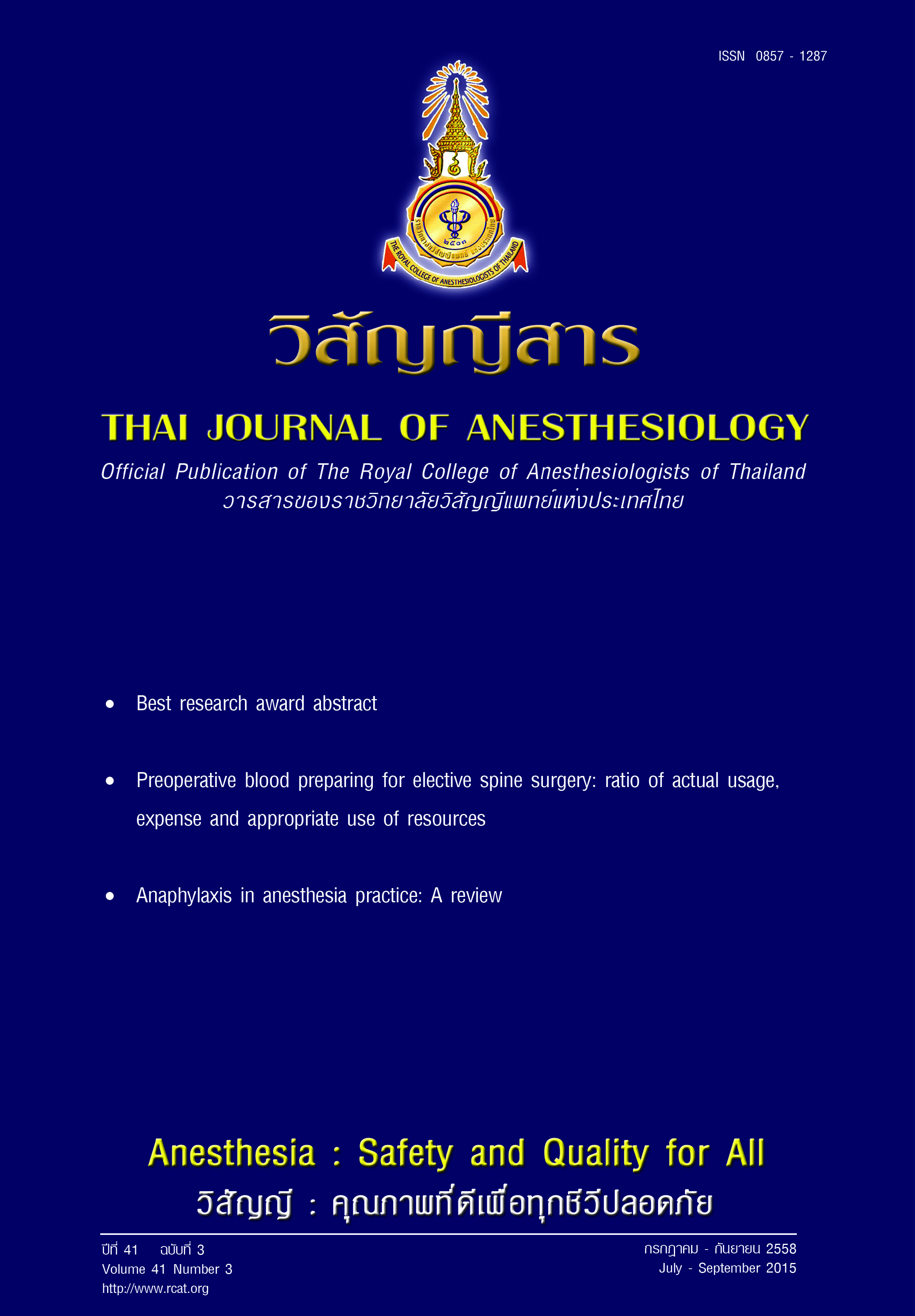Comparison of C-MAC D-Blade videolaryngoscope with conventional blind technique for transesophageal echocardiography probe insertion
Main Article Content
Abstract
Background: Transesophageal echocardiography (TEE) is commonly used in modern cardiac surgery. The failure rates of TEE insertion were reported very low (0.18% - 1.9%). However, in some patients had a very difficult to apply the TEE probe with a blind manner in the esophagus. The objective of this study is to determine whether under the direct vision with the Videolaryngoscope, C-MAC D-blade, can facilitate the TEE probe insertion comparing to the conventional technique. Objective: To compare C-MAC D-blade videolaryngoscope with conventional blind technique for TEE probe insertion.
Method: Thirty patients in cardiac surgical room were randomized into two groups. The study group was placed TEE with C-MAC D-blade videolaryngoscope and the control group was inserted TEE probe with blind technique. Inserting time, number of attemps and complications were recorded during TEE probe manipulation.
Result: The C-MAC D-blade can assist TEE probe insertion with easily in the first attempt, but no statistical significance (p value = 0.4832). The duration of C-MAC D-blade assisted were longer than conventional technique with statistical significance (p value = 0.006). The blood pressure and heart rate were higher in C-MAC D-blade group. There was one case of lip trauma in this study in the C-MAC group.
Conclusion: TEE probe insertion by C-MAC D-blade videolaryngoscope was not different from conventional technique in term of time and number of attempts.
เปรียบเทียบการใช้ C-MAC D-Blade Videolaryngoscope และ Conventional Blind Technique ในการใส่ Transesophageal Echocardiography Probe
บทนำ: ในปัจจุบันมีความนิยมการใช้ transesophageal echocardiography (TEE) ระหว่างการผ่าตัดหัวใจ และหลอดเลือดแดงใหญ่ จากการศึกษาของ Kallmeyer1 และ Daniel2 พบอุบัติการณ์การใส่ TEE probe ไม่สำเร็จร้อยละ 0.18 และ 1.9 ตามลำดับ และมีกรณีศึกษาของ Hirabayashi3 สามารถทำการใส่ TEE probe ได้ง่ายโดยใช้ videolaryngoscope (ชนิด GlideScope) ในผู้ป่วยที่ใส่ TEE probe ยาก จึงเป็นที่มาของแนวทาง การศึกษาการใช้ videolaryngoscope (ชนิด C-MAC D-blade) ที่มีใช้อยู่ว่าน่าจะช่วยทำให้การใส่ TEE probe ได้ง่าย
วัตถุประสงค์: เพื่อศึกษาการใช้ videolaryngoscope ช่วยในการใส่ TEE probe เปรียบเทียบกับ conventional blind technique และติดตามดูภาวะแทรกซ้อนที่เกิดขึ้นในช่วงระหว่างที่ใช้อุปกรณ์ชนิดนี้
วิธีการศึกษา: เป็น การศึกษาแบบ randomize control study ในผู้ป่วยที่มาผ่าตัดทางด้านหัวใจและหลอดเลือดแดงใหญ่ จำนวน 30 คน โดยแบ่งเป็น 2 กลุ่ม กลุ่ม A ใส่ TEE probe ด้วยแบบเทคนิค blind กับกลุ่ม B ใส่ โดยใช้ C-MAC D-blade videolaryngoscope ช่วย ทำการบันทึกจำนวนครั้งที่ใส่ เวลาที่ใช้ในการใส่ ภาวะแทรกซ้อนในช่วงระหว่างใส่ TEE probe
ผลการศึกษา: C-MAC videolaryngoscope ช่วยในการใส่ TEE probe ได้ง่ายและสำเร็จภายในครั้งแรก ทุกราย เมื่อเทียบกับกลุ่มที่ใส่แบบเทคนิค blind แต่ไม่มีความแตกต่างอย่างมีนัยสำคัญทางสถิติ (p-value 0.483) และใช้เวลาในการใส่นานกว่าอย่างมีนัยสำคัญทางสถิติ (p-value 0.006) มีความดันเลือดและอัตราชีพจรสูงขึ้น จากค่าพื้นฐานร้อยละ 20 จำนวน 3 และ 6 เหตุการณ์ในกลุ่มเทคนิค blind และ C-MAC D-blade ตามลำดับ และมีริมฝีปากบนแตก 1 ราย ในกลุ่ม C-MAC D-blade
สรุปผลการศึกษา: การใช้ videolaryngoscope ช่วยใส่ TEE probe พบว่าไม่มีความแตกต่างอย่างมีนัยสำคัญทางสถิติเมื่อเทียบกับ conventional blind technique ในแง่ ของเวลาที่ใช้ในการใส่และจำนวนครั้งที่ใส่ โดยที่อาจมีความเสี่ยงของการใช้เครื่องมือชนิดนี้ได้


